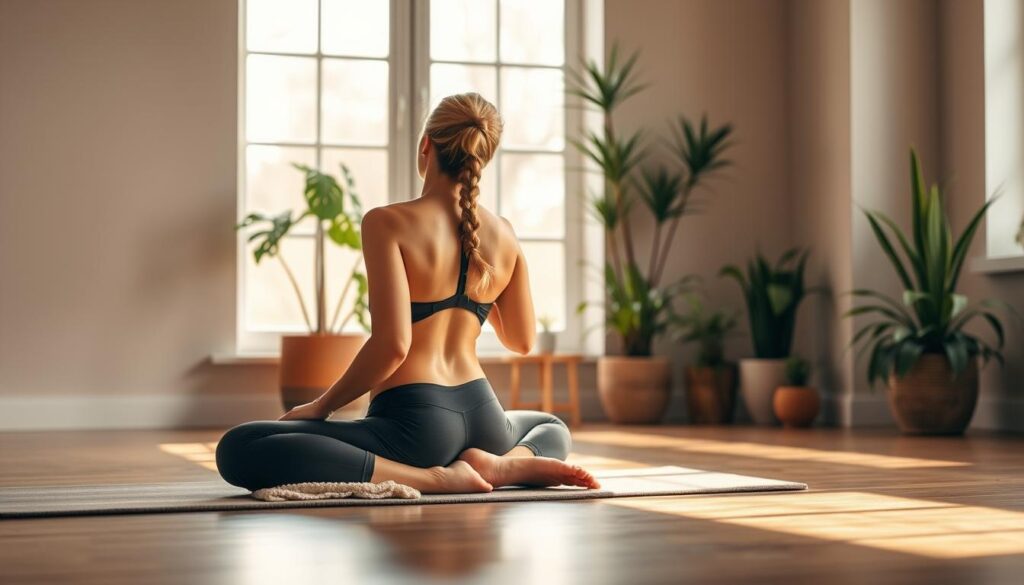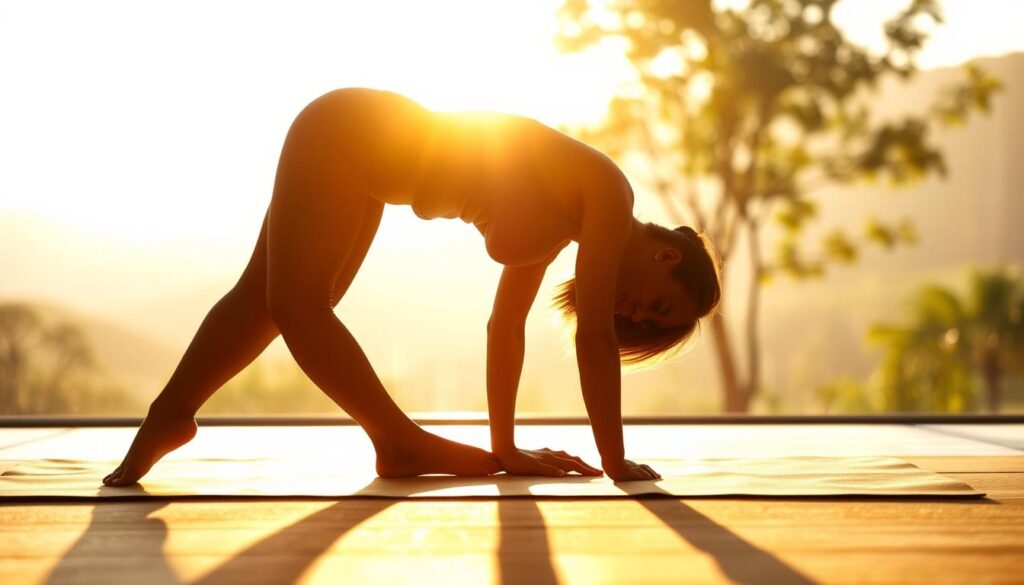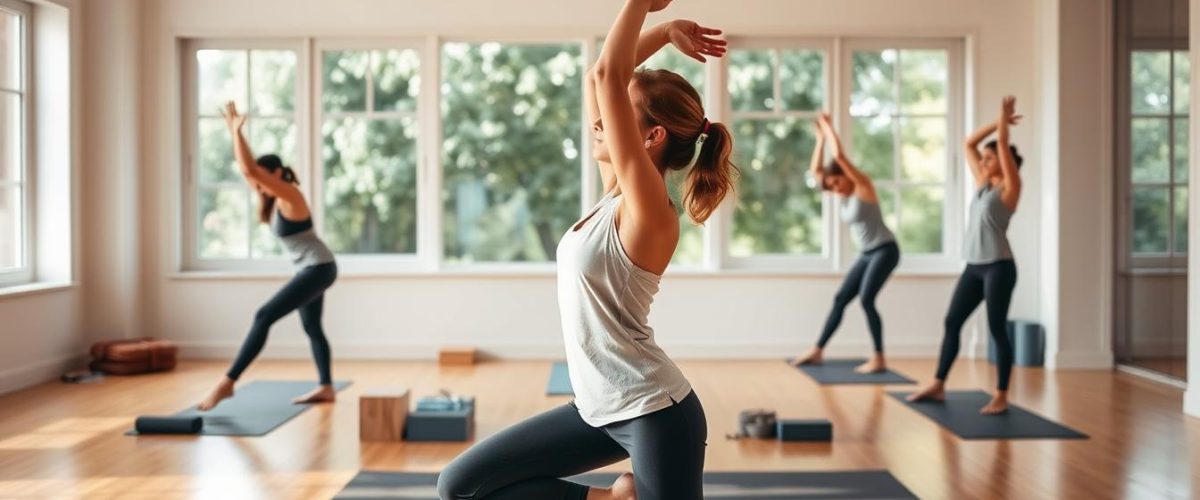Starting your day with a simple morning stretch routine can make a big difference. It boosts your energy and flexibility, setting a positive tone for the day.
Imagine waking up feeling refreshed and ready to take on the day. A short stretching routine can help you feel that way. By adding morning stretch exercises to your daily routine, you can improve your well-being and mood.
As you start your day with a 10-minute morning stretch routine, you’ll feel more flexible and less tense. This simple practice can have a lasting impact on your daily life.
Why a Morning Stretch Routine is Important
Morning stretching is a simple yet effective way to enhance your daily routine. By adding a few minutes of stretching to your morning, you can enjoy many benefits. These benefits help set a positive tone for the day.
Benefits of Stretching in the Morning
Stretching in the morning boosts blood flow and energy. It makes you feel more alert and awake. It also helps reduce muscle tension and improves flexibility.
By starting your day with stretching, you feel invigorated and ready for anything. It prepares you for the day ahead.
How Stretching Improves Flexibility
Regular morning stretching makes your muscles and tendons longer. This increases your flexibility. It makes daily activities easier and lowers injury risk.
As you keep up with your morning stretch routine, you’ll see your mobility and comfort improve. You’ll feel more comfortable moving around.
Boosting Your Mood with Morning Stretches
Morning stretching is good for your physical health and mental well-being. It releases endorphins, or “feel-good” hormones. These hormones boost your mood and reduce stress.
Starting your day with a positive and relaxed mindset is key. It helps you tackle challenges with a better attitude.
Getting Started with Your Stretch Routine
Starting a morning stretch routine is all about setting the right scene. It’s key to pick the right spot and time for your stretches.
Choosing the Right Environment
The place where you stretch matters a lot. Find a quiet, comfy spot where you can stretch without any interruptions. Natural light is best as it helps your body clock.
Make sure the room is just right in temperature. A place that’s too warm or cold can mess up your stretching. A good yoga mat or non-slip surface can also help avoid injuries.
The Best Time to Stretch
Mornings are great for stretching because they boost energy and flexibility. But, pick a time that fits your life. Being regular is what makes stretching a habit.
| Time of Day | Benefits |
|---|---|
| Morning | Boosts energy, improves flexibility, and sets a positive tone for the day. |
| Afternoon/Evening | Can help relieve stress and tension accumulated throughout the day. |
Really, the best time to stretch is when you can do it every day. Try out different times to see what works for you.
Essential Equipment for Your Stretch Routine
You don’t need special gear to start stretching in the morning. But, using a few simple tools and wearing comfy clothes can make a big difference. The right tools can help avoid injuries and boost your flexibility, making stretching better.
Props That Can Enhance Your Stretch
Props can offer support and deepen your stretches. Here are some common ones:
- A yoga mat for grip and cushioning
- Blocks or straps to support your body in various stretches
- A blanket or towel for extra grip or padding
These tools are great for beginners or when you need more flexibility. They help you keep the right form and get the best from your quick morning stretching routine.
Comfortable Clothing for Stretching
Wearing comfy, flexible clothes is key for a good stretch. You need clothes that let you move freely without getting in the way. Think about wearing:
- Breathable fabrics like cotton or moisture-wicking synthetics
- Stretchy pants or shorts that move with your body
- A comfortable top that doesn’t restrict your movements
Dressing right for your morning stretch lets you focus on your movements and breathing. This makes your routine more effective.
Warm-Up: Preparing Your Body
Before starting your morning stretch routine, it’s key to warm up gently. This step gets your muscles ready for stretching. It also lowers injury risk and boosts your routine’s effectiveness.
Gentle Movements to Begin With
Starting with gentle movements is vital for a good warm-up. Begin with simple neck rotations, shoulder rolls, and wrist circles. These easy morning stretches loosen the upper body, improve blood flow, and get your muscles ready for more stretching.
Then, do some light cardio like jogging in place or jumping jacks. These activities raise your heart rate and warm up your muscles more. Adding best morning stretches to your routine can greatly improve your flexibility and overall health.
Importance of Warm-Up Stretches
Warm-up stretches are more than just a start to your stretching routine. They’re a crucial part of it. They reduce muscle stiffness, improve range of motion, and boost performance. A proper warm-up prepares you for a more effective stretching session.
| Warm-Up Activity | Benefits |
|---|---|
| Neck Rotations | Loosens neck muscles, improves flexibility |
| Shoulder Rolls | Relaxes shoulder muscles, reduces tension |
| Light Cardio | Increases heart rate, warms up muscles |
Adding these gentle movements to your morning routine prepares you for the day. It improves flexibility and reduces muscle tension. Remember, a good warm-up is the base of an easy morning stretch routine that offers lasting benefits.
Full-Body Stretch Routine
Starting your day with a full-body stretch routine boosts your flexibility and well-being. It targets major muscle groups, making you feel more energized and ready for the day.
Neck Stretches to Release Tension
Neck stretches are key for releasing tension and improving flexibility. To do a simple neck stretch, slowly tilt your head to the right, bringing your ear towards your shoulder. Hold for 30 seconds and then switch sides. This releases stress and tension in the neck.
Another good neck stretch is tilting your head forward, keeping your chin to your chest, and holding for 30 seconds. This stretch reduces strain on your neck muscles.
Shoulder Rolls for Upper Body Relaxation
Shoulder rolls are a simple yet effective way to relax your upper body. Roll your shoulders forward and backward in a circular motion. Repeat this 10-15 times to reduce tension and improve flexibility in your shoulders.
Back Stretches to Alleviate Discomfort
Back stretches help alleviate discomfort and improve your posture. Stand with your feet shoulder-width apart and then interlock your hands behind your back. Lean back, stretching your chest and shoulders, and hold for 30 seconds. This reduces tension in your upper back.
Leg and Hamstring Stretches
Leg and hamstring stretches are crucial for improving flexibility and reducing muscle tension. To stretch your hamstrings, sit on the floor with your legs straight out in front of you. Lean forward, reaching for your toes, and hold for 30 seconds. This improves flexibility and reduces muscle soreness.
Another effective stretch for your legs involves standing with your feet shoulder-width apart and then bending forward at the hips. Keep your knees slightly bent and hold for 30 seconds to stretch your hamstrings and calves.
Incorporating Breathing Techniques
Adding conscious breathing to your morning stretches can greatly boost your well-being. This mix makes your morning stretch routine even more effective. You’ll get more out of your practice.

Using the right breathing techniques is key to getting the most from your stretches. It helps improve flexibility, lowers muscle tension, and encourages relaxation.
How to Breathe Properly While Stretching
To breathe right while stretching, take deep, diaphragmatic breaths. Breathe in slowly through your nose, letting your belly rise. Then, breathe out slowly through your mouth, feeling your belly fall.
This breathing method calms your mind and relaxes your muscles.
Benefits of Deep Breathing for Relaxation
Deep breathing has many benefits for relaxation and well-being. Adding it to your morning stretch routine can lower stress and anxiety. It also improves your mood and helps your body recover from exercise.
Moreover, deep breathing brings calm to your mind. It helps you feel more centered and ready for the day.
Stretching Tips for Beginners
Starting your day with a simple morning stretch routine can change your life. It’s key to remember a few tips for a safe and effective practice.
Common Mistakes to Avoid
Beginners often make mistakes that can hurt. Avoid bouncing or forcing your stretches. Move slowly and smoothly into each stretch, holding for a few seconds.
Don’t ignore your body’s signals. If you feel pain or discomfort, stop right away. Be consistent but gentle, letting your body get more flexible over time.
| Common Mistake | Safe Alternative |
|---|---|
| Bouncing or forcing stretches | Slow, smooth movements into each stretch |
| Ignoring pain or discomfort | Stopping immediately if pain occurs |
| Inconsistent practice | Gentle, daily stretching routine |
How to Listen to Your Body
Listening to your body is key when starting a morning stretch routine. Pay attention to your breathing and any muscle sensations. If you feel pain or discomfort, adjust or stop the stretch. Deep breathing can help you relax and get the most out of your stretches.
Flexibility improves with consistent practice. Be patient and celebrate small achievements. This way, you’ll not only improve your flexibility but also live a healthier, more balanced life.
Creating a Consistent Routine
Morning stretching can greatly boost your health and flexibility. To make it a habit, create a routine that fits your life and stick to it.
Finding the Best Time for You
The morning is often seen as the best time for stretching. But, the best time is really when it fits your schedule. Try different times to see what works for you.
Think about your daily routine and how you feel. If mornings are tough, try stretching during your lunch break or before bed.
| Time of Day | Benefits | Considerations |
|---|---|---|
| Morning | Boosts energy, improves flexibility | Can be challenging for non-morning people |
| Lunch Break | Reduces stress, improves focus | May be rushed or interrupted |
| Evening | Relaxes muscles, prepares for bed | Can interfere with bedtime if done too vigorously |
How to Stay Motivated
It’s key to stay motivated for a consistent stretching routine. Set achievable goals and track your progress to keep you going.
Another good idea is to find a stretching buddy or join a class. It adds fun and accountability to your routine.

By using these tips, you can make morning stretching a fun and lasting part of your day.
Modifications for Different Fitness Levels
It’s important to adjust your stretch routine based on your fitness level. This ensures a safe and effective practice. Whether you’re just starting or looking to push yourself, there are ways to make it work for you.
For Beginners
Beginners should start with gentle stretches that slowly get more intense. Focus on big muscle groups like hamstrings, quadriceps, and hip flexors. Start with shorter holds and fewer reps, then increase as you get stronger.
- Begin with simple neck stretches, tilting your head to the side and forward.
- Incorporate shoulder rolls to loosen upper body tension.
- Use props like blocks or straps if you find certain stretches challenging.
For Advanced Practitioners
For those more experienced, you can make your routine more challenging. Deepen the stretches or add more complex movements. Try dynamic stretches like leg swings or arm circles to boost flexibility and get ready for more intense activities.
- Try deeper lunges or downward-facing dog to challenge your flexibility.
- Incorporate breathing techniques to enhance relaxation and focus.
- Experiment with different variations of stretches to target specific muscle groups.
By adjusting your morning stretch routine to fit your fitness level, you can enjoy an effective morning stretch routine. It will improve your flexibility, lower injury risk, and start your day off right.
Stretching Safety Tips
To get the most out of your morning stretching, it’s important to know the safety tips. This helps prevent injuries and boosts flexibility. Always be mindful of your body’s limits and take the right precautions.
Preventing Injury While Stretching
Preventing injuries while stretching is key. Start by warming up properly before deep stretches. Simple movements like arm circles and leg swings can get you ready.
It’s also vital to listen to your body. If you feel sharp pain, stop right away. Remember to breathe naturally and avoid bouncing to avoid strain.
| Safety Tip | Description | Benefit |
|---|---|---|
| Warm-Up | Gentle movements before stretching | Prepares muscles, reduces injury risk |
| Listen to Your Body | Stop if you feel pain | Avoids strain and potential injury |
| Natural Breathing | Breathe normally while stretching | Enhances relaxation, improves flexibility |
When to Seek Professional Advice
If you’re new to stretching or have health concerns, talk to a healthcare pro or a certified fitness expert. They can give you tailored advice and help you create a safe and effective stretching routine.
Also, if you have medical conditions or injuries, get professional advice. They can adjust your stretching routine to fit your needs, ensuring you stretch safely and effectively.
Conclusion: Start Your Day Right
Starting your day with a 10 minute morning stretch routine can change your day for the better. It sets a positive tone for the rest of the day. By adding an easy morning stretch to your daily routine, you can get more flexible, feel happier, and have more energy.
Benefits of a Morning Stretch Routine
A morning stretch routine has many benefits. It can reduce muscle tension, improve blood flow, and boost your overall health. Just a few minutes each morning can make a big difference.
Commit to Your Routine
To get the most from your 10 minute morning stretch, make it a daily habit. As stretching becomes a part of your morning, you’ll feel more awake and ready for the day.



One Response